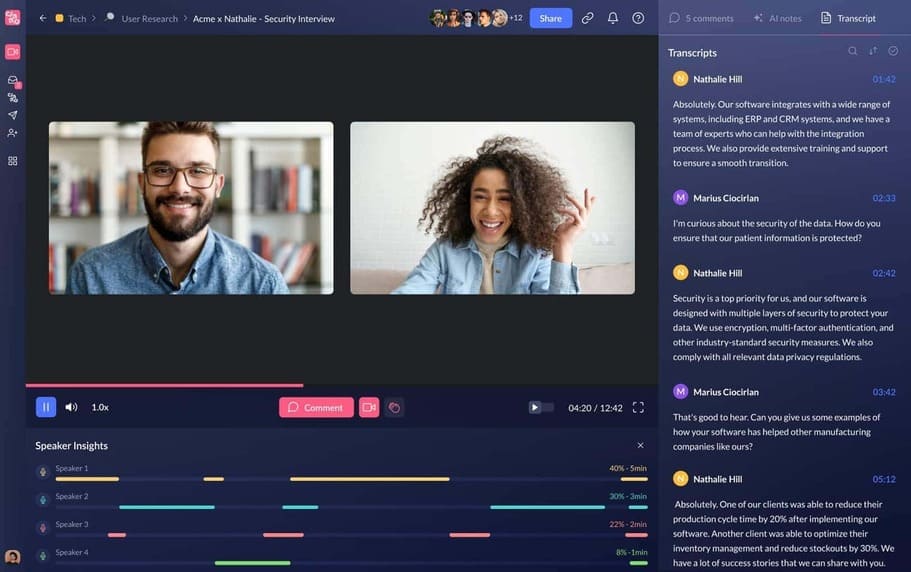Why should you use an asynchronous communication tool?
Asynchronous vs synchronous communication: what is the difference?
Synchronous communication, asynchronous communication, these are words we don’t hear that much but that actually refer to aspects of our everyday lives. The difference is simple: synchronous communication refers to a real-time communication: a phone call or a meeting for instance. Asynchronous communication, on the other hand, refers to a communication that implies a delayed response.
What is an asynchronous communication tool?

An asynchronous communication tool is not more than a way of communicating asynchronously. We’ll see examples of asynchronous communication tools later but know that it should allow you to communicate a message without being physically/virtually present at the moment when your interlocutor receives it.
Benefits of asynchronous communication
There are several advantages to using asynchronous communication:
- Flexibility: Asynchronous communication allows you to join people that would not be available for synchronous communication. It’s especially useful to accommodate different schedules and time zones.
- Efficiency: Asynchronous communication helps communicating quicker than synchronous communication. Instead of a 30 minute or 1 hour meeting, the same information can be transmitted in short messages or even videos if you use Claap.
- Documentation: Asynchronous communication makes the recording of information easier. No need to record a meeting or take notes, the information is kept and consultable at any time.
The traditional asynchronous communication tools

I could have mentioned handwritten letters, physical bulletin boards or whatever… But let’s be honest, these modes of communication, especially in the professional environment, are becoming less and less used. Because they’re being replaced by emails. Email is the king of asynchronous communication tools. Everybody sends emails, even my grandmother!
The principle is simple: you leave a message (the email) and your interlocutor responds whenever he/she wants.
Voicemail

An asynchronous communication tool is a way to leave a message to somebody when he/she is not available at the moment. This is exactly why voicemail is one of the traditional asynchronous communication tools: you try to call somebody, you can't, so you leave a voicemail. The recipient can listen and respond to the message at their convenience.
Forum
A forum is a place where you can post your messages and questions. A forum may be public or private. If it’s public (on websites like Reddit or Quora for instance), anybody can give you an answer. If it’s private, a defined number of people will be able to see your message and answer to it. In a company, you may have several forums corresponding to different categories of questions you could ask (IT for instance).
Instant messaging

This one is a bit ambiguous, I’ll concede that. If we are talking about instant messages why isn’t it considered a synchronous communication tool? Well because your interlocutor may take a while before responding. It depends on many things: your company’s culture, the personality of your interlocutor … But at the end, if your interlocutor doesn’t respond instantly, he/she will have the message later. And, that’s why it’s an asynchronous communication tool.
I had to present these options to you. But if you’re there, there are chances that you’re looking for an innovative asynchronous communication tool that will make you gain efficiency and productivity. I have exactly what you need.
The top 5 asynchronous communication tools
After having tested many different asynchronous communication tools, here is my top 5:
- Claap, the best tool overall
- Jira, the best for software development projects
- Figma, the best for design projects
- Miro, the best for asynchronous brainstorming
- Gainsight, the best for customer success management
Claap, the best asynchronous communication tool

I might not be the most objective person here, but at least I know Claap very well… And that’s how I know that Claap is the best asynchronous communication tool available on the market. Let me show you why:
Claap’s key benefits
- Asynchronous meeting feature: With Claap’s screen recording feature, you can start recording claaps: 2 to 5 minute videos in which you can easily communicate your findings, give updates… Actually you can do anything you would have done with a traditional synchronous meeting. But without the traditional cons of such a meeting (fit everybody’s agenda, spend 30 minutes at least …)
- Automatic description: With Claap’s audio transcription capabilities combined with its powerful AI meeting summary features, Claap provides an automatic description of your videos. If you can’t watch the video, you can read the summary!
- Collaboration and engagement features: Your teammates can easily interact with your claaps on Claap’s platform. They can react to it, ask questions… and all that very accurately as Claap allows you to do it on a specific part of the screen.
- Intuitive workspace: Recording claaps is great, but you need a specific place to share them right? Claap offers workspaces organized into categories for that. With Claap, nothing is easier than asynchronous communication!
Claap’s limitations
- Limits of the Free Plan: Claap only allows 10 video uploads with the free plan.
Price
- Starter: Free with an upload limit of 10 videos.
- Team: $10/month per user with unlimited videos upload/storage.
- Enterprise: Custom
If you want to benefit from Claap's paid features but still have reservations about making a financial commitment, we've got you covered. Claap offers a 14-day free trial that grants you unlimited access to all premium features at no cost.
Jira, the best for software development projects

Key Benefits
- Improved communication: Jira allows users to communicate asynchronously using a collaborative board where team members can create tickets and globally communicate on their activities easily.
- Real time monitoring of activities: Jira allows your team to always be up to date with the latest activities in the project. Jira notably displays dashboards with which the team members have access to any information relevant to them.
- Powerful Agile views: Jira allows you to use Kanban and Scrum boards if you want an Agile project management.
Limitations
- Lack of collaboration features: In comparison with other tools such as Claap, Jira lacks collaboration features that would help replacing a synchronous communication tool.
- Quite difficult to get the hang of: Mastering the tool may pose challenges and require a bit of a learning curve.
Price
- Free: with max 10 users, unlimited project boards, backlog, timeline and 2 GB of storage
- Standard: $8.15/month per user with max 35,000 users and 250 GB of storage
- Premium: $16/month per user with advanced roadmaps, sandbox and release tracks and unlimited storage
- Enterprise: Custom
Figma, the best for design projects

Key Benefits
- Design file collaboration: Figma allows you to work on design projects efficiently directly on Figma platform. Different users can modify the documents simultaneously or asynchronously.
- Teamwork functionalities: With Figma, you can easily share design prototypes and collect feedback. This is extremely useful to progress quickly on design projects.
- Version history feature: Even if a project you’re working on is modified during your absence, you can get back to previous versions in one-click if needed.
Limitations
- Internet connection required: You can’t work locally on your designs if you use Figma as it requires an internet connection to work.
- Specific PC configuration needed: To use Figma, you will need a PC with at least 4GB of RAM and an Intel HD 3000 (or similar) graphic card. While most of the PCs will check the boxes, this is still a limitation you have to take into consideration.
- Not always smooth: When working with Figma, you might encounter bugs and slowdowns, especially if you don’t have a particularly performant device.
Price
- Free: Free with 3 Figma files, unlimited personal files and unlimited collaborators
- Professional: €12/month per user with unlimited Figma files, shared projects, unlimited version history
- Organization: €45/month per user with design system analytics and centralized file management
- Enterprise: €75/month per user with dedicated workspaces, advanced design systems and network access restrictions
Miro, the best for asynchronous brainstorming

Key Benefits
- Whiteboard collaboration: Miro gives you access to 1000+ templates to brainstorm collaboratively with your team members.
- Wide range of collaboration features: Miro allows you to give feedback by leaving comments and sticky notes, but also by mentioning teammates to notify them of something.
- Activity feed: Miro has an activity feed feature which gives you a real-time overview of all recent updates and changes on the project.
Limitations
- Session expiration issues: Miro sometimes closes sessions sooner than expected, which can make you lose unsaved changes on your work.
- Lack of template re-usability: While Miro allows you to customize your templates, you can’t save them to gain time when you want to re-use them, which is not optimized.
Price
- Free: with single workspace and 3 editable boards
- Starter: $8/month per user with single workspace and unlimited editable boards, unlimited project folders for sharing and private boards for more control on the accesses
- Business: $16/month per user with unlimited private and secure workspaces
- Enterprise: Custom
Gainsight, the best for customer success management

Key Benefits
- Visual dashboards: Gainsight displays company and customer information using intuitive dashboards, saving you from having to communicate to have a vision on key figures.
- Increased team collaboration: Gainsight allows you to interact with your teammates to communicate asynchronously and efficiently, using mentions and tags notably.
- Automatic communication: Gainsight enables you to automate email sendings to optimize your asynchronous communication process.
Limitations
- Interface not user-friendly: The configuration of the tool can be tricky and the interface could be more intuitive.
- Limited integration with other tools: Gainsight would benefit from a better integration with other tools (Slack for instance) to improve the asynchronous communication possibilities.
Price
Gainsight plans are not publicly available so you’ll have to contact them to obtain more information.
Conclusion
If you’re looking for an asynchronous communication tool to use for a very specific use case (design for instance), you may have better options but overall, Claap will be the ideal asynchronous communication tool.
Actually, you will certainly have to mix synchronous and asynchronous communication, at least at the beginning. And that’s also why you should choose Claap. Claap has many functionalities that make corporate communication easier, like meeting recording and automatic transcription.
But the best way to discover all the features of Claap is by actually testing it. Do it now and change your way of working (free plan available with no credit card required).






